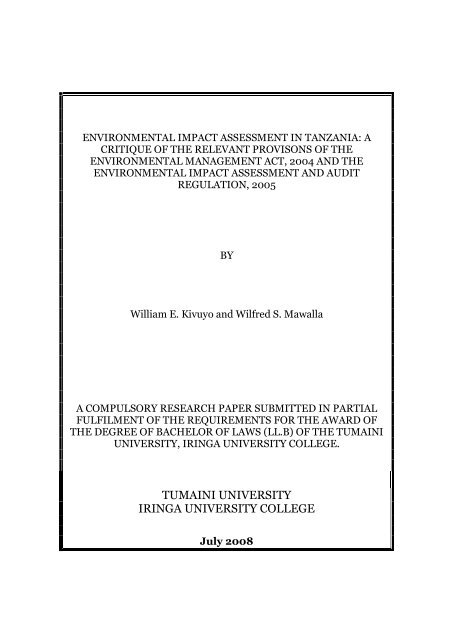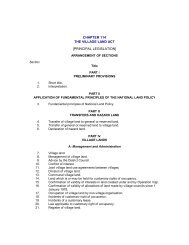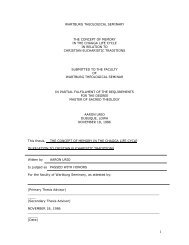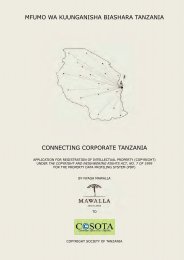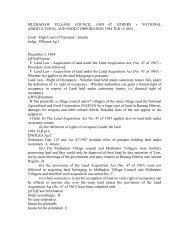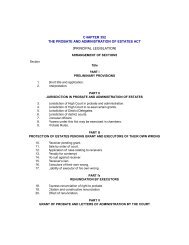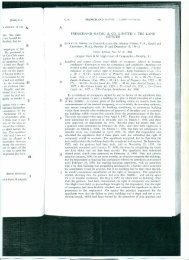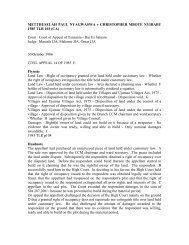Environmental Impact Assessment in Tanzania by Wilfred Mawalla ...
Environmental Impact Assessment in Tanzania by Wilfred Mawalla ...
Environmental Impact Assessment in Tanzania by Wilfred Mawalla ...
Create successful ePaper yourself
Turn your PDF publications into a flip-book with our unique Google optimized e-Paper software.
COPYRIGHTThis work is a copyright protected under the Copyrights and Neighbour<strong>in</strong>g Rights Act No. 7 of1999, Laws of <strong>Tanzania</strong> and International <strong>in</strong>struments for the protection of <strong>in</strong>tellectual propertyrights.And as such no part of this research paper may be reproduced, copied, adopted, abridged orstored <strong>in</strong> any retrieval system or transmitted <strong>in</strong> any form <strong>by</strong> any means; electronic, photocopy<strong>in</strong>g,record<strong>in</strong>g or otherwise, save for the application of ‘fair use doctr<strong>in</strong>e,’ without prior writtenpermission of either the authors or of the Dean, Faculty of Law, Tuma<strong>in</strong>i University, Ir<strong>in</strong>gaUniversity College.~ iii ~
ACKNOWLEDGEMENTDespite the fact that this research paper is a result of our own efforts, it will be unfair not tomention, at this stage, some people who have facilitated its completion. Although, it is notpossible to mention <strong>by</strong> names all of them, who, <strong>in</strong> one way or another have contributed to thecompletion of this research work, we would like to express our special gratitude to the follow<strong>in</strong>gpersons;Our special thanks go to our parents, for enabl<strong>in</strong>g us to be at the college <strong>in</strong> all aspects; fromf<strong>in</strong>anc<strong>in</strong>g college fees, research costs and their cont<strong>in</strong>ued moral and parental support which haveall together made this research possible.We also owe much thanks to our supervisor, Ms. Joy Faida who, despite be<strong>in</strong>g overwhelmedwith other duties still spared time to go through work for this study; encourag<strong>in</strong>g, and pos<strong>in</strong>gcritical comments and corrections from time to time, efforts which have, largely shaped thisresearch paper and made it a reality.We feel also <strong>in</strong>debted to Mr. Eliamani I. Laltaika, Mr. Nyaga P. <strong>Mawalla</strong>, Ellen Zambetakis,Mathew Eliakim, Protas Mwalongo and all those who assisted us <strong>in</strong> one way or the other toaccess, obta<strong>in</strong> and use data for the completion of this study. “We thank you and will alwaysremember you.”~ v ~
ABSTRACTSound environmental management and the need to protect natural resources, has necessitatedmany countries, <strong>in</strong>clud<strong>in</strong>g <strong>Tanzania</strong> to put down strict legislative measures to protect theenvironment; measure which <strong>in</strong>clude environmental impact assessment. This research criticallyanalyses the relevant provisions concern<strong>in</strong>g environmental impact assessment under the<strong>Environmental</strong> Management Act, 2004 and the <strong>Environmental</strong> <strong>Impact</strong> <strong>Assessment</strong> and AuditRegulation, 2005.Chapter one which provides an <strong>in</strong>troductory aspect of the study conta<strong>in</strong>s a background to theresearch, statement of the problem, objectives, and the significance of the study. It alsoprescribes the hypothesis and methodology used to carry out the study.Chapter two of this research conta<strong>in</strong>s a detailed discussion on the concept of environment impactassessment; its evolution, objectives and procedure as the focus of the chapter.In chapter three the research establishes, a critical analysis of the relevant provisions concern<strong>in</strong>genvironmental impact assessment under the <strong>Environmental</strong> Management Act, 2004 and the<strong>Environmental</strong> <strong>Impact</strong> <strong>Assessment</strong> and Audit Regulation, 2005. This chapter thus is apresentation of a detailed critique of the Act and Regulation which po<strong>in</strong>ts out specificweaknesses and strengths <strong>in</strong>herent <strong>in</strong> the law.F<strong>in</strong>ally <strong>in</strong> chapter four, this study makes conclusive remarks which sum up the discussion <strong>in</strong>previous chapters. The chapter suggests recommendations for an effective EIA.~ vi ~
ABBREVIATIONSAct -The <strong>Environmental</strong> Management Act, 2004EIA-<strong>Environmental</strong> <strong>Impact</strong> <strong>Assessment</strong>EMA, 2004 -The <strong>Environmental</strong> Management Act, 2004NCSSD-National Conservation Strategy for Susta<strong>in</strong>able DevelopmentNEAP-National <strong>Environmental</strong> Action PlanNEMC-National Environment Management CouncilRegulation -The <strong>Environmental</strong> <strong>Impact</strong> <strong>Assessment</strong> and Audit Regulation, 2005~ vii ~
TABLE OF CONTENTSPRELIMINARY PAGESDeclaration .................................................................................................................................... iCertification ................................................................................................................................. iiCopyright .................................................................................................................................... iiiDedication ................................................................................................................................... ivAcknowledgement ........................................................................................................................vAbstract ....................................................................................................................................... viAbbreviations ............................................................................................................................. viiTable of contents ....................................................................................................................... viii~ viii ~
CHAPTER ONEINTRODUCTION1.0 BACKGROUND TO THE RESEARCH PROBLEM ......................................................11.1 STATEMENT OF THE PROBLEM .................................................................................51.2 AIMS AND OBECTIVES OF THE STUDY1.2.1 AIMS …………………………………………………………………………….71.2.2 OBJECTIVES……………………………………………………………………71.3 RESEARCH HYPOTHESIS…………………………………………………………….81.4 SIGNIFICANCE OF THE STUDY……………………………………………………..81.5 LITERATURE REVIEW………………………………………………………………..91.6 LIMITATION OF THE STUDY……………………………………………………….111.7 RESEARCH METHODOLOGY ....................................................................................11CHAPTER TWOTHE CONCEPT OF EIA, IT’S EVOLUTION, OBJECTIVES AND EIA PROCESS2.0 INTRODUCTION ……………………………………………………………………..122.1 THE CONCEPT OF EIA .................................................................................................122.2 THE EVOLUTION OF EIA ............................................................................................132.3 THE OBJECTIVES OF EIA ...........................................................................................15~ ix ~
2.4 THE EIA PROCESS ........................................................................................................162.5 CONCLUSION…………………………………………………………………………27CHAPTER THREECRITICAL ANALYSIS OF THE ENVIRONMENTAL MANAGEMENT ACT, 2004 ANDENVIRONMENTAL IMPACT ASSESSMENT AND AUDIT REGULATION, 20053.0 INTRODUCTION……………………………………………………………………..283.1 A CRITIQUE OF EIA PROVISIONS UNDER THE EMA, 20043.1.1 STRENGTH…………………………………………………………………….283.1.2 WEAKNESS……………………………………………………………………343.2 A CRITIQUE OF EIA PROVISIONS UNDER THE REGULATION, 20053.2.1 STRENGTH……………………………………………………………………..363.2.2 WEAKNESS…………………………………………………………………….403.3 CONCLUSION…………………………………………………………………………43CHAPTER FOURCONCLUSION AND RECOMMENDATIONS4.0 INTRODUCTION ...........................................................................................................444.1 CONCLUSION ..................................................................................................... 444.2 RECOMMENDATIONS……………………………………………………………….47BIBLIOGRAPHY .........................................................................................................................50~ x ~
CHAPTER ONEINTRODUCTION1.0 BACKGROUND OF THE PROBLEMThe <strong>Environmental</strong> impact assessment (EIA) is a tool used to improve decision-mak<strong>in</strong>gand ensure that development options under consideration are environmentally, sociallyand economically sound and susta<strong>in</strong>able. The assessment is concerned with theidentification, prediction and evaluation the foreseeable impacts, both beneficial andadverse, of proposed development projects and alternatives. It aims to elim<strong>in</strong>ate orm<strong>in</strong>imise negative impacts and optimise positive impacts through mitigation andenhancement measures. EIA relates to a process rather than a particular activity.Further, environmental impact assessment is an important management tool forimprov<strong>in</strong>g the long-term viability of projects. It can be used to prevent mistakes that canbe expensive and damag<strong>in</strong>g <strong>in</strong> environmental, social and economic terms. Humanactivities are alter<strong>in</strong>g natural cycles and systems on an unprecedented scale, and thecumulative effects of these activities are estimated to be on par with bio-physicalprocesses as an agent of ecological change.<strong>Tanzania</strong>, like many other develop<strong>in</strong>g countries, is keen to protect and preserve itsenvironment from destruction. <strong>Tanzania</strong> did not have a comprehensive environmental1
law with mandatory requirements for <strong>Environmental</strong> <strong>Impact</strong> <strong>Assessment</strong> (EIA). Thisomission may be expla<strong>in</strong>ed <strong>in</strong> part as due to the marg<strong>in</strong>al place that environmentalmatters played <strong>in</strong> the period preced<strong>in</strong>g the Rio Conference <strong>in</strong> 1992. In the post-Rioperiod, the reluctance to <strong>in</strong>tegrate EIA requirements <strong>in</strong> legislation may be seen <strong>in</strong> thecontext of the liberalization and deregulation policies <strong>in</strong> force s<strong>in</strong>ce mid 1980s whoseconcern has been privatization of the common wealth and promotion of private foreign<strong>in</strong>vestment.In other words, the overrid<strong>in</strong>g desire to create "conducive environment" for <strong>in</strong>vestorsexpla<strong>in</strong>s the omission of EIA requirements <strong>in</strong> our national <strong>in</strong>vestment law as well as thepolitico-bureaucratic control of the EIA processes <strong>in</strong> other legislations which regulate<strong>in</strong>vestment <strong>in</strong> the country. The effect has been that even where statute requirescompliance with environmental considerations, <strong>in</strong> practice this is either totally ignored orits spirit subverted while keep<strong>in</strong>g <strong>in</strong>tact the veneer of legality.Despite the absence of EIA legislation and <strong>in</strong>stitutional framework, impact assessmenthas been applied <strong>in</strong> <strong>Tanzania</strong> largely on ad-hoc basis for over 20 years. S<strong>in</strong>ce the firstEIA <strong>in</strong> 1980s, several have been undertaken <strong>in</strong> different projects.The need for more effective environmental management mechanisms <strong>in</strong> <strong>Tanzania</strong> hasbeen widely acknowledged. No wonder, therefore, that the omission of EIA requirements<strong>in</strong> various environmental and natural resource management legislation has been a source2
of considerable criticism <strong>in</strong> both the official and academic literature on natural resourcemanagement <strong>in</strong> the country. Much of this criticism has centred on the need to haveeffective regulatory controls <strong>in</strong> place <strong>in</strong> view of the grow<strong>in</strong>g importance of foreign<strong>in</strong>vestment <strong>in</strong> <strong>Tanzania</strong>.With time, the Government came up with a National <strong>Environmental</strong> Action Plan (NEAP)which was touted as 'a first step' <strong>in</strong> mak<strong>in</strong>g the fundamental changes needed to br<strong>in</strong>genvironmental considerations <strong>in</strong>to the ma<strong>in</strong>stream of decision-mak<strong>in</strong>g <strong>in</strong> our country. 1The NEAP, dubbed as the outcome of "distillation of lessons and thoughts onenvironment and development from a national perspective", gave recognition toenvironmental impact assessment as one of the "priority <strong>in</strong>struments" of environmentalpolicy. The NEAP also urged the <strong>in</strong>corporation of EIA approaches <strong>in</strong>to all aspects ofplann<strong>in</strong>g and decision-mak<strong>in</strong>g. 2Later, the Government of <strong>Tanzania</strong> adopted a National Conservation Strategy forSusta<strong>in</strong>able Development (NCSSD) which was prepared <strong>by</strong> the National EnvironmentManagement Council (NEMC). The NCSSD document observed the trend away fromdirect state <strong>in</strong>volvement <strong>in</strong> economic activity which has obviously stimulated economicgrowth has, however, not been replaced with effective regulatory framework which couldallow market forces to work effectively while safeguard<strong>in</strong>g certa<strong>in</strong> national <strong>in</strong>terests such1 See foreword <strong>by</strong> M<strong>in</strong>ister of Tourism, Natural Resources and Environment, MTNRE, 1994 available athttp://www.zmuc.dk/entoweb/guidel<strong>in</strong>es.htm, (retrieved on 18/05/2008)2 Tundu Antiphas Lissu, <strong>Environmental</strong> <strong>Impact</strong> <strong>Assessment</strong> of Foreign Investment Projects, 19993
as environmental quality and equitable <strong>in</strong>come distribution. It further observed theabsence of a legal regime for EIA <strong>in</strong> the plann<strong>in</strong>g processes as one of the "legal issues ofnational concern", not<strong>in</strong>g that "without a mandatory EIA process, no obligation exists toassess and monitor the effects of projects and government activities on the environment".It, therefore, urged the promotion of EIA methodology <strong>in</strong> the plann<strong>in</strong>g andimplementation processes of all relevant m<strong>in</strong>istries regulat<strong>in</strong>g government activities aswell as private <strong>in</strong>vestment, especially the Investment Promotion Centre (IPC, now knownas TIC) "where most <strong>in</strong>vestment projects are scrut<strong>in</strong>ized". In addition, it proposed thecreation of a legal regime requir<strong>in</strong>g mandatory EIA of major development projects withsignificant impacts on the environment, with the EIA procedures requir<strong>in</strong>g cross-sectoralconsultation <strong>in</strong> specific cases of government decision-mak<strong>in</strong>g.In December 1997, the National <strong>Environmental</strong> Policy which was passed <strong>by</strong> thegovernment which recognized the importance of EIA as a plann<strong>in</strong>g tool to <strong>in</strong>tegrateenvironmental considerations <strong>in</strong> decision-mak<strong>in</strong>g process <strong>in</strong> order to ensure thatunnecessary damage to the environment is avoided. It has, furthermore, proclaimed theneed for mak<strong>in</strong>g EIA processes a mandatory requirement "to ensure that environmentalconcerns receive due and balanced consideration <strong>in</strong> reconcil<strong>in</strong>g urgent developmentneeds and long-term susta<strong>in</strong>ability". The policy has, <strong>in</strong> addition, promised theformulation of requisite guidel<strong>in</strong>es and specific criteria for conduct<strong>in</strong>g EIA processes aspart of the strategies to implement the policy. The cornerstone of these processes,4
accord<strong>in</strong>g to the Policy, will be the <strong>in</strong>stitution of the mechanisms for public consultationsand public hear<strong>in</strong>gs <strong>in</strong> the EIA procedures. 3As the result of the government struggle <strong>in</strong> protect<strong>in</strong>g its environment, it enacted the<strong>Environmental</strong> Management Act, 2004 and the <strong>Environmental</strong> <strong>Impact</strong> <strong>Assessment</strong> andAudit Regulation, 2005 which conta<strong>in</strong>s relevant provisions govern<strong>in</strong>g the entire EIAprocess and makes it mandatory that EIA should be carried out prior to the establishmentof certa<strong>in</strong> projects. However, it is observed that despite such struggle <strong>by</strong> the government,such provisions govern<strong>in</strong>g EIA process are weak hence <strong>in</strong>adequate, thus dim<strong>in</strong>ish<strong>in</strong>g thewhole purpose of EIA.1.1 STATEMENT OF THE PROBLEMIt is realized that the newly enacted <strong>Environmental</strong> Management Act, 2004 and the<strong>Environmental</strong> <strong>Impact</strong> <strong>Assessment</strong> and Audit Regulation 2005 have made seriousattempts to <strong>in</strong>corporate EIA provisions that governs the entire process. However it isnoted that these provisions are not sufficient for effective protection and conservation ofthe environment <strong>in</strong> <strong>Tanzania</strong> as they conta<strong>in</strong> with<strong>in</strong> themselves weakness and loopholeswhich may defeat the whole purpose of EIA.3 Lissu T, supra note 25
Such weaknesses and loopholes which subsist <strong>in</strong> the provisions govern<strong>in</strong>g EIA may allowestablishment of some projects or activities which may result <strong>in</strong>to massive adverseimpacts to the environment.Thus, consider<strong>in</strong>g the fact that we are liv<strong>in</strong>g <strong>in</strong> an era <strong>in</strong> which the whole world is mov<strong>in</strong>gtowards liberalized economy to which <strong>Tanzania</strong> is not exceptional, foreign <strong>in</strong>vestmentwhich is flow<strong>in</strong>g <strong>in</strong>to the country is based on the exploitation of the f<strong>in</strong>ite naturalresources such as m<strong>in</strong>erals, wildlife/forestry and coastal and mar<strong>in</strong>e resources. Therefore,the nature and character of the regulatory system for this <strong>in</strong>vestment has significantimpacts to the environment which pose a threat to the ultimate susta<strong>in</strong>ability of thenatural resources and the livelihood of various communities who depend on the naturalresource for their survival. This <strong>in</strong> the long run will make it difficult for <strong>Tanzania</strong> toachieve the ultimate goals of EIA which <strong>in</strong>volves decision-mak<strong>in</strong>g and ensur<strong>in</strong>g thatdevelopment options under consideration are environmentally, socially and economicallysound and susta<strong>in</strong>able.For effective carry<strong>in</strong>g out of the study the follow<strong>in</strong>g research question shall guide theresearchers;Are the relevant provisions govern<strong>in</strong>g <strong>Environmental</strong> <strong>Impact</strong> <strong>Assessment</strong>sufficient for effective protection of environment?6
1.2 AIMS AND OBJECTIVES OF THE STUDY1.2.1 AIMS OF THE STUDYThis study aims at exam<strong>in</strong><strong>in</strong>g the relevant provisions govern<strong>in</strong>g the entire EIA process ofthe <strong>Environmental</strong> Management Act, 2004 and the <strong>Environmental</strong> <strong>Impact</strong> <strong>Assessment</strong>and Audit Regulation, 2005 <strong>in</strong> order to determ<strong>in</strong>e the adequacy of such provisions <strong>in</strong> theprotection and susta<strong>in</strong>able management of the environment <strong>in</strong> <strong>Tanzania</strong>.1.2.2 OBJECTIVES OF THE STUDYThat, this study is <strong>in</strong>tended to explore the relevant provisions govern<strong>in</strong>g EIA process <strong>in</strong>order to exam<strong>in</strong>e the strengths and/or weaknesses that exist <strong>in</strong> the said provisions.That, the study further <strong>in</strong>tends to provide possible solutions to the weak provisions (if anyis found) of the Act relat<strong>in</strong>g to EIA process.That, the study also <strong>in</strong>tends to persuade the relevant authorities to make amendments tothe weak provisions (if any is found) and replace the same with the more effective ones.Moreover, the study <strong>in</strong>tends to recommend for modern and more effective environmentalmanagement tools other than EIA.7
1.3 RESEARCH HYPOTHESISThat some of the relevant provisions of the <strong>Environmental</strong> Management Act, 2004 andthe <strong>Environmental</strong> <strong>Impact</strong> <strong>Assessment</strong> and Audit Regulation, 2005 are <strong>in</strong>adequate <strong>in</strong> theprotection and susta<strong>in</strong>able management of the environment.1.4 SIGNIFICANCE OF THE STUDYThis research is <strong>in</strong>tended to serve the follow<strong>in</strong>g:The study will be important as it will create awareness and enlighten the society and thegovernment on the weaknesses of some relevant provisions govern<strong>in</strong>g EIA so thatappropriate measures may be taken <strong>by</strong> the government.Recommendations that shall be put forward at the end of this study shall operate as achallenge on the part of law makers, decision makers and relevant authorities concern<strong>in</strong>gEIA <strong>in</strong> order that they adopt sufficient provisions for effective and susta<strong>in</strong>ablemanagement of the environment.S<strong>in</strong>ce this research will be kept <strong>in</strong> the university library, it will serve as a reference toother academicians, <strong>Tanzania</strong>ns and non - <strong>Tanzania</strong>ns because it is go<strong>in</strong>g to provide a8
comprehensive study on recommendations that will be provided at the end of the researchon the possible amendments on the EIA provisions.1.5 LITERATURE REVIEWThe follow<strong>in</strong>g are a few publications and writ<strong>in</strong>gs which were reviewed <strong>by</strong> theresearchers that motivated them <strong>in</strong> one way or another to conduct this study.The work of Mwalyosi, R., Hughes R., Spooner, B., Kikula, I., Mohamed, S. andSosovele, H 4 is one of the publications reviewed. Their paper expla<strong>in</strong>s the role of EIA andsummarises the basic procedures <strong>in</strong>volved <strong>in</strong> its implementation and explores its potentialrole <strong>in</strong> contribut<strong>in</strong>g to improved decision-mak<strong>in</strong>g and development plann<strong>in</strong>g <strong>in</strong> <strong>Tanzania</strong>.Another publication which was reviewed is one <strong>by</strong> Mwalyosi, R. and Hughes, R. 5 Theirstudy evaluates the performance of EIA process <strong>in</strong> <strong>Tanzania</strong> as plann<strong>in</strong>g andenvironmental management tool.Furthermore, Mwalyosi, R., Hughes, R. and Howlett, D.J.B <strong>in</strong> their work 6 provide an<strong>in</strong>troduction to <strong>Environmental</strong> <strong>Impact</strong> <strong>Assessment</strong> (EIA) and its potential role <strong>in</strong>4 <strong>Environmental</strong> <strong>Impact</strong> <strong>Assessment</strong> <strong>in</strong> <strong>Tanzania</strong>: A Brief<strong>in</strong>g Paper, February 1996.5 The Performance of EIA <strong>in</strong> <strong>Tanzania</strong>: an assessment, IIED <strong>Environmental</strong> plann<strong>in</strong>g Issues No. 14. IRAResearch Paper No. 41. 1998.6 Introduction Course on <strong>Environmental</strong> <strong>Impact</strong> <strong>Assessment</strong> <strong>in</strong> <strong>Tanzania</strong>: Resource Handbook, 19999
<strong>Tanzania</strong>. The work is also designed to help improve understand<strong>in</strong>g of the contributionthat EIA can make towards susta<strong>in</strong>able development plann<strong>in</strong>g <strong>in</strong> <strong>Tanzania</strong>.Lissu, T. A. <strong>in</strong> his work 7 <strong>in</strong>tends to exam<strong>in</strong>e environmental law and policy <strong>in</strong> <strong>Tanzania</strong>particularly <strong>in</strong> respect of foreign <strong>in</strong>vestment <strong>in</strong> <strong>Tanzania</strong> with a view to show<strong>in</strong>g themanner <strong>in</strong> which social and environmental considerations have been <strong>in</strong>tegrated <strong>in</strong> thedecision-mak<strong>in</strong>g processes regard<strong>in</strong>g foreign <strong>in</strong>vestment and the regulation thereof.Last but not least, is the work <strong>by</strong> Harmer, C. 8 which was based <strong>in</strong> assess<strong>in</strong>g whetherimprov<strong>in</strong>g the effectiveness of EIA <strong>in</strong> the UK, is dependent on the use of follow-up. Theresults of his study suggest that the use of follow-up should be extended <strong>in</strong> the UK, <strong>in</strong>order to improve EIA effectiveness.It is recognized that, despite the fact that the above cited works have not specifically dealtwith the provisions of the <strong>Environmental</strong> Management Act, 2004 relat<strong>in</strong>g to EIA, suchworks have been of great help <strong>in</strong> understand<strong>in</strong>g the whole concept of EIA, its process andthe mechanisms that are necessary for an effective EIA. Thus, proper understand<strong>in</strong>g ofEIA will help the researchers <strong>in</strong> carry<strong>in</strong>g out their study.7 <strong>Environmental</strong> <strong>Impact</strong> <strong>Assessment</strong> of Foreign Investment Projects: A Study <strong>in</strong> the Law, Policy andGovernmental Decision-mak<strong>in</strong>g <strong>in</strong> <strong>Tanzania</strong>, March 19998 Is Improv<strong>in</strong>g the Effectiveness of <strong>Environmental</strong> <strong>Impact</strong> <strong>Assessment</strong> <strong>in</strong> the UK Dependent on the Use ofFollow-up? Views of <strong>Environmental</strong> Consultants. (A Thesis presented <strong>in</strong> part-fulfillment of the degree ofMaster of Science <strong>in</strong> accordance with the regulations of the University of East Anglia, August 2005)10
1.6 LIMITATIONS OF THE STUDYThe follow<strong>in</strong>g are some of the limitations or challenges fac<strong>in</strong>g the researchers <strong>in</strong> thecourse of this study;1. Time factor2. F<strong>in</strong>ancial limitation3. Data <strong>in</strong>accessibility4. Lack of cooperation on part of the government officials1.7 RESEARCH METHODOLOGYThis study is an analytical type of research because it basically looks at the<strong>Environmental</strong> Management Act, 2004 and the <strong>Environmental</strong> <strong>Impact</strong> <strong>Assessment</strong> andAudit Regulation, 2005 on a critical perspective <strong>in</strong> the protection and preservation ofenvironment <strong>in</strong> <strong>Tanzania</strong>.Therefore, this study will only employ secondary data which <strong>in</strong>cludes the <strong>Environmental</strong>Management Act, 2004 and the <strong>Environmental</strong> <strong>Impact</strong> <strong>Assessment</strong> and Audit Regulation,2005.11
CHAPTER TWOTHE CONCEPT, EVOLUTION, OBJECTIVES AND EIA PROCESS2.0 INTRODUCTIONThis chapter <strong>in</strong>tends to briefly expla<strong>in</strong> the concept of EIA <strong>by</strong> provid<strong>in</strong>g its mean<strong>in</strong>g andterms associated to it. It further expla<strong>in</strong>s the orig<strong>in</strong> of EIA and its evolution <strong>in</strong> <strong>Tanzania</strong>;its objectives and the entire process <strong>in</strong>volved <strong>in</strong> conduct<strong>in</strong>g EIA <strong>in</strong> <strong>Tanzania</strong>.2.1 THE CONCEPT OF EIA<strong>Environmental</strong> <strong>Impact</strong> <strong>Assessment</strong> (EIA) is one of the major tools relied upon <strong>by</strong>governments and societies worldwide to help effective environmental management. It canbe def<strong>in</strong>ed as ‘a systematic process that exam<strong>in</strong>es the environmental consequences ofdevelopment actions <strong>in</strong> advance’ and is primarily used to assist <strong>in</strong> the identification,prediction and mitigation of environmental impacts caused <strong>by</strong> certa<strong>in</strong> newdevelopments. 9<strong>Environmental</strong> impact assessment is, <strong>in</strong> its simplest form, a plann<strong>in</strong>g tool that is nowgenerally regarded as an <strong>in</strong>tegral component of sound decision mak<strong>in</strong>g. As a plann<strong>in</strong>g9 Clare Harmer, Is Improv<strong>in</strong>g the Effectiveness of <strong>Environmental</strong> <strong>Impact</strong> <strong>Assessment</strong> <strong>in</strong> the UK Dependenton the Use of Follow-up? Views of <strong>Environmental</strong> Consultants: A Thesis presented <strong>in</strong> part-fulfilment of thedegree of Master of Science <strong>in</strong> accordance with the regulations of the University of East Anglia, August2005 at p. 312
tool it has both an <strong>in</strong>formation gather<strong>in</strong>g and decision mak<strong>in</strong>g component which providesthe decision maker with an objective basis for grant<strong>in</strong>g or deny<strong>in</strong>g approval for aproposed development. 10The terms 'impact assessment' and 'environmental impact assessment' are umbrella termsfrequently used to cover a broad range of techniques, e.g. social impact assessment (SIA),risk assessment (RA), environmental impact assessment (EIA) and health impactassessment (HIA). To date, EIA itself has been applied generally at the project level, but<strong>in</strong>creas<strong>in</strong>g attention is now be<strong>in</strong>g given to impact assessment at the level of policies,plans and programmes (this is known as strategic environmental assessment - SEA).2.2 THE EVOLUTION OF EIA<strong>Environmental</strong> impact assessment emerged <strong>in</strong> 1969 and has s<strong>in</strong>ce become ‘a powerfulenvironmental safeguard <strong>in</strong> the project plann<strong>in</strong>g process’. 11 Over 100 different countrieshave developed <strong>in</strong>dividual EIA systems each with vary<strong>in</strong>g levels of sophistication. Theprocess was developed <strong>in</strong> the USA and came <strong>in</strong>to operation as a part of the National<strong>Environmental</strong> Policy Act (NEPA) <strong>in</strong> 1969. In the 15 years follow<strong>in</strong>g its enactment, theestablishment of other mandatory EIA systems were conf<strong>in</strong>ed to a relatively smallnumber of countries, <strong>in</strong>clud<strong>in</strong>g Canada, Australia and France. Less formalised and often10 Justice La Forest, Friends of the Oldman v. Canada et al. (1991)11 Clare H, supra note 913
more limited provisions for environmental assessment were also <strong>in</strong>troduced <strong>in</strong> a numberof countries. However, s<strong>in</strong>ce 1985 a major expansion <strong>in</strong> the number of formalised EIAsystems has occurred.In <strong>Tanzania</strong> though there was no legislation or <strong>in</strong>stitutional framework, impactassessment was applied largely on ad-hoc basis for over 20 years. S<strong>in</strong>ce the first EIA <strong>in</strong>1980s, several others have been undertaken <strong>in</strong> different sectors <strong>in</strong> the country. In 1995,the <strong>Tanzania</strong>n government came up with a National <strong>Environmental</strong> Action Plan (NEAP)which was touted as 'a first step' <strong>in</strong> mak<strong>in</strong>g the fundamental changes needed to br<strong>in</strong>genvironmental considerations <strong>in</strong>to the ma<strong>in</strong>stream of decision-mak<strong>in</strong>g <strong>in</strong> our country. 12The NEAP, gave recognition to environmental impact assessment as one of the "priority<strong>in</strong>struments" of environmental policy. Later <strong>in</strong> the same year, the Government of<strong>Tanzania</strong> adopted a National Conservation Strategy for Susta<strong>in</strong>able Development(NCSSD) which observed the absence of a legal regime for EIA <strong>in</strong> the plann<strong>in</strong>g processesas one of the "legal issues of national concern", not<strong>in</strong>g that "without a mandatory EIAprocess, no obligation exists to assess and monitor the effects of projects and governmentactivities on the environment". In December 1997, the National <strong>Environmental</strong> Policywas passed <strong>by</strong> the government which recognized the importance of EIA as a plann<strong>in</strong>gtool to <strong>in</strong>tegrate environmental considerations <strong>in</strong> decision-mak<strong>in</strong>g process <strong>in</strong> order toensure that unnecessary damage to the environment is avoided. It has furthermore,proclaimed the need for mak<strong>in</strong>g EIA processes a mandatory requirement "to ensure that12 See note 1 (supra)14
environmental concerns receive due and balanced consideration <strong>in</strong> reconcil<strong>in</strong>g urgentdevelopment needs and long-term susta<strong>in</strong>ability". 132.3 OBJECTIVES OF EIAThe objective of EIA is to provide decision-makers with a focused evaluation of thelikely environmental consequences of sanction<strong>in</strong>g a proposed development action, beforea decision is taken and at a time when it can actually affect the outcome. The<strong>Environmental</strong> <strong>Impact</strong> Statement produced can be considered alongside other plann<strong>in</strong>grelated documentation to enable the decision-maker to reach an <strong>in</strong>formed conclusionabout the acceptability of the proposal. Complet<strong>in</strong>g an EIA should lead to more balanceddecision-mak<strong>in</strong>g, as due consideration and weight should be given to environmentalfactors, <strong>in</strong> conjunction with other factors such as costs.Furthermore, EIA is a tool used to aid the developer. Although EIA is undoubtedly oftenseen as a time-consum<strong>in</strong>g and expensive hurdle, EIA can be a great benefit to developers.If the process is fully <strong>in</strong>tegrated <strong>in</strong>to the project design cycle, it can enable developers toidentify environmental issues at an early stage, allow<strong>in</strong>g them to m<strong>in</strong>imise or elim<strong>in</strong>atethe adverse impacts on the environment. This may lead to improved relations between the13 Lissu T, supra note 215
developer, the local authority and the local communities and therefore lead to a smootherplann<strong>in</strong>g permission process.In the longer term, the ultimate purpose of EIA is to help to achieve susta<strong>in</strong>abledevelopment. In theory, EIA enables developers to identify, avoid and/or mitigateadverse impacts at the design stage and <strong>in</strong> some cases the development might beprevented, all of which can be seen as a move towards achiev<strong>in</strong>g more susta<strong>in</strong>abledevelopment.In addition, EIA has also been described as ‘a powerful tool that has been remarkablysuccessful <strong>in</strong> allow<strong>in</strong>g for the consideration of social, economic and environmentaleffects <strong>in</strong> the review of major development projects’. It provides for the <strong>in</strong>volvement ofthe public, departments of the Government and Government agencies <strong>in</strong> the review of theproposed activities. 142.4 EIA PROCESSThe steps for conduct<strong>in</strong>g EIA are described under the <strong>Environmental</strong> <strong>Impact</strong> <strong>Assessment</strong>and Audit Regulations, 2005. These Regulations are made under the <strong>Environmental</strong>Management Act, 2004. Generally, there are n<strong>in</strong>e steps for conduct<strong>in</strong>g EIA as provided14 Clare H, supra note 9 at pp 8,916
for under the Regulations which <strong>in</strong>clude: project registration and screen<strong>in</strong>g; scop<strong>in</strong>g;basel<strong>in</strong>e study; impact assessment ; impact mitigation and enhancement measures;preparation of environmental impact statement; review of environmental impactstatement; environmental monitor<strong>in</strong>g and audit<strong>in</strong>g; and, lastly, decommission<strong>in</strong>g. 15 Theaspects covered <strong>in</strong> each step are as follows:2.4.1 Project Registration and Screen<strong>in</strong>gProject registration is done through submission of a project brief to National<strong>Environmental</strong> Management Council (NEMC) <strong>in</strong> a prescribed form and must conta<strong>in</strong>,among others, the name of the project proponent (developer or sponsor); proposedproject; proposed site; required <strong>in</strong>frastructure and utilities. 16 Upon receipt of the projectbrief, NEMC is required with<strong>in</strong> twenty one days to forward the project brief to otherstakeholders. Upon expiry of twenty one days, NEMC shall conduct project screen<strong>in</strong>g.The screen<strong>in</strong>g criteria <strong>in</strong>volve establish<strong>in</strong>g whether:1. The project will not substantially use natural resources <strong>in</strong> a way that pre-empts theuse, or potential use, of that resource for any other purpose.2. Potential residual impacts on the environment are likely to be m<strong>in</strong>or, or of littlesignificance and easily mitigated.15 Fourth Schedule to the Regulation, 200516 Ibid17
3. The type of project’s environmental impacts and measures for manag<strong>in</strong>g them arewell understood <strong>in</strong> <strong>Tanzania</strong>.4. Reliable means exist for ensur<strong>in</strong>g that impact management measures can and willbe adequately planned and implemented.5. The project will not displace significant numbers of people, families orcommunities.6. The project is not located <strong>in</strong>, and will not affect, any environmentally sensitiveareas such as national parks; wetlands; productive agricultural land; importantarchaeological, historical and cultural sites; areas protected under legislation;areas conta<strong>in</strong><strong>in</strong>g rare or/endangered flora or fauna; areas conta<strong>in</strong><strong>in</strong>g unique oroutstand<strong>in</strong>g scenery; mounta<strong>in</strong>s or developments on or near steep-hill slopes; drytropical forests (e.g. Brachystegia woodlands); development near lakes or itsbeaches; development provid<strong>in</strong>g important resources for vulnerable groups suchas fish<strong>in</strong>g communities along the lake-shore; development near high populationconcentrations or <strong>in</strong>dustrial activities where further development could createsignificant environmental problems; and prime ground water re-charge areas orareas of importance for surface run off of water.18
7. The project type will not result <strong>in</strong>: (a) policy <strong>in</strong>itiatives which may affect theenvironment such as changes <strong>in</strong> agricultural pric<strong>in</strong>g subsidies; (b) major changes<strong>in</strong> land tenure; or (c) changes <strong>in</strong> water use through irrigation, dra<strong>in</strong>age promotionor dams, changes <strong>in</strong> fish<strong>in</strong>g practices.8. The project will not cause: (a) adverse socio-economic impact; (b) landdegradation; (c) water pollution; (d) air pollution; (e) damage to wildlife andhabitat; (f) adverse impact on climate and hydrological circle; and (g) creation of<strong>by</strong>-products, residual or waste m<strong>in</strong>erals which require handl<strong>in</strong>g and disposal <strong>in</strong> amanner that is not regulated <strong>by</strong> exist<strong>in</strong>g authorities.9. The project will not cause significant public concern because of potentialenvironmental changes. The follow<strong>in</strong>g are guid<strong>in</strong>g pr<strong>in</strong>ciples: (a) is the impactpositive; (b) what is the scale of the impact <strong>in</strong> terms of area affected number ofpeople or wildlife; (c) what is the <strong>in</strong>tensity of the impact; (d) what will be theduration of the impact; (e) will there be cumulative effects from the impact; (f) arethe effects politically controversial; (g) have the ma<strong>in</strong> economic, ecological andsocial costs been quantified; (h) will the impact vary <strong>by</strong> social group or gender ;and (i) is there any <strong>in</strong>ternational impact due to the proposed project.10. The project will not necessitate further development which is likely to havesignificant impact on the environment. If, after project screen<strong>in</strong>g, NEMC f<strong>in</strong>ds19
that the project has no significant impact on the environment, it will approve theproject without requir<strong>in</strong>g the developer to undertake EIA. If the council f<strong>in</strong>ds thatthe project will have a significant impact on the environment and the projectreport discloses no mitigation measures, NEMC will require the project developerto undertake a prelim<strong>in</strong>ary assessment if more <strong>in</strong>formation is required <strong>in</strong> mak<strong>in</strong>gdecision on the screen<strong>in</strong>g outcome or a comprehensive EIA.2.4.2 Scop<strong>in</strong>gIf NEMC requests the developer to undertake EIA, the next stage will be scop<strong>in</strong>g. Thepurpose of scop<strong>in</strong>g is to: (a) identify the ma<strong>in</strong> stakeholders that will be negatively orpositively impacted <strong>by</strong> the proposed project; (b) identify stakeholders’ ma<strong>in</strong> concernsregard<strong>in</strong>g the proposed project; (c) identify ma<strong>in</strong> project alternatives; (d) identify likelyimpacts, data requirements, tool and techniques for impact identification, prediction andevaluation; (e) identify project boundaries <strong>in</strong> terms of spatial, temporal and <strong>in</strong>stitutionalaspects; (f) ensur<strong>in</strong>g adequate stakeholder participation <strong>in</strong> all stages of EIA; and (g)preparation of scop<strong>in</strong>g report and terms of reference for EIA. 1717 See supra note 1520
2.4.3 Basel<strong>in</strong>e StudyThe next stage after scop<strong>in</strong>g is conduct<strong>in</strong>g a basel<strong>in</strong>e study. The basel<strong>in</strong>e study <strong>in</strong>volves adetailed survey of the exist<strong>in</strong>g social, economic, physical, ecological, social-cultural and<strong>in</strong>stitutional environment with<strong>in</strong> the project boundary and ensur<strong>in</strong>g that adequatestakeholder participation is engaged.2.4.4 <strong>Impact</strong> <strong>Assessment</strong>Follow<strong>in</strong>g a basel<strong>in</strong>e study, the developer will conduct an impact assessment. <strong>Impact</strong>assessment <strong>in</strong>volves: (a) impact identification, impact prediction and evaluation of impactsignificance follow<strong>in</strong>g a variety of appropriate techniques and approaches; (b) ensur<strong>in</strong>gthat concerns and views from stakeholders are fully taken <strong>in</strong>to account dur<strong>in</strong>g assessmentof impacts; and (c) assess<strong>in</strong>g all possible alternatives and their impacts andrecommend<strong>in</strong>g appropriate options.2.4.5 <strong>Impact</strong> Mitigation and Enhancement Measures<strong>Impact</strong> mitigation and enhancement measures <strong>in</strong>volves prepar<strong>in</strong>g mitigation measures forall negative significant impacts, either <strong>by</strong> elim<strong>in</strong>ation, reduction or remedy<strong>in</strong>g them; (b)prepar<strong>in</strong>g enhancement measures for all significant positive effects aris<strong>in</strong>g from theproject so as to <strong>in</strong>crease the contribution from the project to social development and21
environmental conservation; (c) prepar<strong>in</strong>g a mitigation and enhancement plan for allsignificant negative impacts and positive effects, with details about <strong>in</strong>stitutionalresponsibilities and costs where appropriate; and (d) prepar<strong>in</strong>g a monitor<strong>in</strong>g plan andenvironmental and social management plan with details about <strong>in</strong>stitutionalresponsibilities , monitor<strong>in</strong>g framework, parameters, <strong>in</strong>dicators for monitor<strong>in</strong>g and costsfor monitor<strong>in</strong>g where appropriate.2.4.6 Preparation of <strong>Environmental</strong> <strong>Impact</strong> StatementAfter conduct<strong>in</strong>g an impact assessment, the next stage is to prepare an impact statement.Preparation of an environmental impact statement entails (a) prepar<strong>in</strong>g an environmentalimpact statement adher<strong>in</strong>g to contents outl<strong>in</strong>ed <strong>in</strong> the Regulations; 18 (b) preparation of atechnical summary <strong>in</strong> both Kiswahili and English; and (c) preparation of all technicaldetails which must be appended to the statement.2.4.7 Review of <strong>Environmental</strong> <strong>Assessment</strong> StatementIn this step, NEMC <strong>in</strong> association with the developer review the environmental impactstatement with a view to ensur<strong>in</strong>g its adherence to review criteria and any guidel<strong>in</strong>es thatmay be issued under the Regulations. NEMC may call for a public hear<strong>in</strong>g and publicreview of the environmental impact statement <strong>in</strong> accordance with the conditions and18 Regulation 1822
procedures stipulated under the Regulations. Hav<strong>in</strong>g done that NEMC submits a reviewreport to the M<strong>in</strong>ister responsible for the environment with recommendations and alldocuments used <strong>in</strong> the review for approval.2.4.8 <strong>Environmental</strong> Monitor<strong>in</strong>g and Audit<strong>in</strong>gIn this stage, NEMC conducts environmental monitor<strong>in</strong>g <strong>in</strong> order to evaluate theperformance of the mitigation measures specified <strong>in</strong> the environmental and socialmanagement plan as well as monitor<strong>in</strong>g plan. The monitor<strong>in</strong>g process <strong>in</strong>volves:• Verification of impacts, adherence to approved plans, environmental standards andgeneral compliance of the terms and conditions set out <strong>in</strong> the EIA certificate;• Undertak<strong>in</strong>g <strong>by</strong> the developer to monitor the implementation of the project to ensurethat mitigation measures are effective;• Collect<strong>in</strong>g of data that can be used <strong>in</strong> future projects and for environmentalmanagement;• Undertak<strong>in</strong>g <strong>by</strong> NEMC and the project developer to carry out project environmentalaudit;23
• Putt<strong>in</strong>g <strong>in</strong> place mechanisms for stakeholder participation dur<strong>in</strong>g monitor<strong>in</strong>g andaudit<strong>in</strong>g process (which must be def<strong>in</strong>ed and followed); and• Def<strong>in</strong><strong>in</strong>g areas of focus <strong>in</strong> audit exercise which normally <strong>in</strong>cludes (i)implementation/enforcement audit, which takes place when NEMC verifies ifmitigation measures and pollution levels are with<strong>in</strong> limits; (ii) performance/regulatoryaudit that entails identification of compliance to relevant legislation or safety standards;(iii) impact prediction audit (which checks the accuracy and efficacy of the impactprediction <strong>by</strong> compar<strong>in</strong>g them with monitored impacts); (iv) collection and compilation<strong>by</strong> NEMC of <strong>in</strong>formation aris<strong>in</strong>g from audit<strong>in</strong>g for future use; and (v) collection of data<strong>by</strong> the developer from audit<strong>in</strong>g and compil<strong>in</strong>g <strong>in</strong>formation for project management andalso for submission to NEMC.2.4.9 Decommission<strong>in</strong>gThis is the last stage which occurs at the end of the project life. The decommission<strong>in</strong>greport must be prepared either as part of the environmental statement or separately,<strong>in</strong>dicat<strong>in</strong>g how impacts will be dealt with, <strong>in</strong>clud<strong>in</strong>g costs of mitigation measures. Thedecommission<strong>in</strong>g report must ensure that issues such as welfare of workers, resourceusers as well as their general livelihood are not worse off as a result of thedecommission<strong>in</strong>g. The developer must undertake to perform decommission<strong>in</strong>gobligations as per the proposals stipulated <strong>in</strong> the environmental impact statement. NEMC24
cont<strong>in</strong>ues to monitor implementation of decommission<strong>in</strong>g plan, <strong>in</strong>clud<strong>in</strong>g rehabilitationof land and other resources that were affected <strong>by</strong> the project.Therefore, the EIA process can be represented as a series of stages. However, EIA shouldnot be considered as a l<strong>in</strong>ear process as it appears above, but a cyclical activity, withfeedback from later stages to earlier ones as illustrated <strong>in</strong> the diagram below.25
A diagram illustrat<strong>in</strong>g EIA process:26
2.5 CONCLUSIONIt is observed that this chapter has provided a comprehensive mean<strong>in</strong>g of the concept ofEIA and it has traced its evolution. The Chapter also po<strong>in</strong>ts out the objectives and theprocess of EIA.27
CHAPTER THREECRITICAL ANALYSIS OF THE ENVIRONMENTAL MANAGEMENT ACT,2004 AND ENVIRONMENTAL IMPACT ASSESSMENT AND AUDITREGULATION, 20053.0 INTRODUCTIONThis chapter deals with a critical analysis of the EIA provisions under the EMA, 2004and the Regulation, 2005. This chapter therefore presents the f<strong>in</strong>d<strong>in</strong>gs and analysis of theAct and the Regulation through a detailed critique of the same <strong>by</strong> po<strong>in</strong>t<strong>in</strong>g out somespecific weaknesses and strengths <strong>in</strong>herent <strong>in</strong> the Act and the Regulations.PART I3.1 A CRITIQUE OF EIA PROVISONS UNDER THE EMA, 20043.1.1 STRENGTHAfter a thorough scrut<strong>in</strong>y of the EMA, 2004, here<strong>in</strong> below are some of the EIAprovisions identified to be noteworthy;Section 81 of the Act makes it mandatory for a proponent or a developer of a project toundertake or cause to be undertaken at his own cost EIA before the establishment of28
projects specified under the Act. It is observed that such a mandatory requirement ofundertak<strong>in</strong>g EIA before establish<strong>in</strong>g any projects is <strong>in</strong>tended to guarantee protection ofthe environment aga<strong>in</strong>st adverse negative impacts which might be caused <strong>by</strong> suchprojects. Such a requirement enables the relevant authorities based on the EIA conductedto determ<strong>in</strong>e if such projects will have adverse impacts to the environment. In case theprojects are found to have adverse impacts to the environment they will be rejected but ifthe projects have m<strong>in</strong>imum impacts to the environment they will be allowed. This thusguarantees a sound and susta<strong>in</strong>able management of the environment.Furthermore, section 84 of the Act is to the effect that, issuance of EIA certificate <strong>in</strong>respect of any project shall not be a defence <strong>in</strong> any legal proceed<strong>in</strong>gs brought aga<strong>in</strong>st aproponent of a project or undertak<strong>in</strong>g <strong>in</strong> respect of the manner of which the project orundertak<strong>in</strong>g is be<strong>in</strong>g executed, managed or operated. This means that despite the grant ofan EIA certificate, such certificate shall neither act as a bar to prosecution nor defence forfailure to comply with conditions conta<strong>in</strong>ed there<strong>in</strong>. This is because some proponentsmay decide to operate activities different from the ones permitted <strong>by</strong> the EIA result<strong>in</strong>g<strong>in</strong>to adverse negative impacts to the environment and seek to rely on the certificate as adefence. This provision will arguably compel potential developers to comply withconditions there<strong>by</strong> ensur<strong>in</strong>g environmental protection.Moreover, section 85 of the Act requires the Council to determ<strong>in</strong>e the scope of EIS <strong>by</strong>agree<strong>in</strong>g with the proponents on such matters as the prescribed issues that must be29
addressed <strong>by</strong> EIS; persons and <strong>in</strong>stitutions that must be consulted dur<strong>in</strong>g the preparationof EIS and methodologies and approaches <strong>in</strong> the collect<strong>in</strong>g, collat<strong>in</strong>g and analyz<strong>in</strong>g therequired data, among others. This enables the Council prior to the preparation of EIS <strong>by</strong>the proponent to be aware of all the issues to be addressed <strong>by</strong> the EIS. Further to that, theCouncil may confirm or give further directives on persons or <strong>in</strong>stitutions to be consulteddur<strong>in</strong>g the preparation of the EIS, and also to determ<strong>in</strong>e and approve the methodologiesand approaches <strong>in</strong> the collect<strong>in</strong>g, collat<strong>in</strong>g and analyz<strong>in</strong>g the required data that are to beused <strong>by</strong> the proponent. This therefore enables the Council to be <strong>in</strong> a position to determ<strong>in</strong>ethe scope of EIS <strong>in</strong> order for it to be effective and come out with fruitful results.Section 87(2) of the Act provides that the council may for purposes of carry<strong>in</strong>g outreviews, set up a cross-sectoral technical advisory committee to advice it on reviews ofEIS. Apparently, the Council while review<strong>in</strong>g EIS may be faced with technical issueswhich require assistance of experts on that particular field. Therefore, the council may setup a cross-sectoral technical advisory committee to advice them on such technical mattersencountered dur<strong>in</strong>g the review of the EIS. A cross-sectoral technical advisory committeeis significant because of the contribution of different experts such as lawyers, surveyorsand scientists to mention a few. This is relevant for a comprehensive EIA.Section 89(1) of the Act requires public participation <strong>in</strong> EIA especially of those likely tobe affected <strong>by</strong> the project be<strong>in</strong>g the subject of an EIA study or review. The sectionguarantees public participation on EIA process. The importance of public participation on30
EIA process is that the public can contribute ideas and <strong>in</strong>formation that can help to avoidunforeseen problems, improve project design, and contribute to monitor<strong>in</strong>g anddevelopment of mitigation measures for adverse impacts. Experience also shows thatdevelopment projects imposed on local communities often fail or under-perform becausethey lack a sense of local ownership and public support. Therefore, the <strong>in</strong>volvement ofpublic <strong>in</strong> EIA process especially those likely to be affected is highly important foreffective operation of the project itself and protection of the environment.Section 97 of the Act requires a fresh EIA study to be undertaken <strong>by</strong> the holder of EIAcertificate and submit an EIS with<strong>in</strong> such time as the council may prescribe due to any ofthe follow<strong>in</strong>g: that there is substantial change or modification of the project orundertak<strong>in</strong>g or <strong>in</strong> the manner <strong>in</strong> which the project is be<strong>in</strong>g operated; that the project orundertak<strong>in</strong>g posses environmental threats which could not be reasonably foreseen at thetime of the study or review; and if <strong>in</strong> due course it is established that the <strong>in</strong>formation ordata given <strong>by</strong> the proponent or undertak<strong>in</strong>g <strong>in</strong> previous EIA process was <strong>in</strong>accurate, falseor <strong>in</strong>tended to mislead the council. This acts as a control measure especially to thedishonest proponents who may change or modify the manner of operat<strong>in</strong>g their projectsthat might be contrary to the conditions stipulated under the certificate.This is also important <strong>in</strong> case the project or undertak<strong>in</strong>g possess threats to theenvironment which at the time of the <strong>in</strong>itial study could not reasonably be foreseen.Furthermore, the proponent will also be required to conduct a fresh EIA upon realization31
y the Council that he wilfully provided <strong>in</strong>accurate or false <strong>in</strong>formation aimed atmislead<strong>in</strong>g the Council. Therefore, this provision is important s<strong>in</strong>ce it will ensureoperation of projects <strong>in</strong> accordance with conditions and <strong>in</strong> a manner prescribed <strong>in</strong> thecertificate. The provision further requires for fresh EIA to be undertaken on projects thatpose threats to the environment which were not <strong>in</strong>itially foreseen. The provision alsorequires the proponents who provide <strong>in</strong>accurate <strong>in</strong>formation which might mislead theCouncil to undertake a fresh EIA.Section 99(1) of the Act provides for monitor<strong>in</strong>g of the environment. It requires thecouncil <strong>in</strong> consultation with the relevant m<strong>in</strong>istry or government agency to monitor allenvironmental criteria and phenomena <strong>in</strong> order to make an assessment of any possiblechanges <strong>in</strong> the environment and their possible impacts. The Act further requiresmonitor<strong>in</strong>g of project operations with the view to determ<strong>in</strong><strong>in</strong>g its immediate and longterm effects on the environment. It is observed that further to the undertak<strong>in</strong>g of EIA, theAct is also keen <strong>in</strong> ensur<strong>in</strong>g that the projects or undertak<strong>in</strong>gs are operated <strong>in</strong> accordancewith the EIA conducted. This is <strong>by</strong> requir<strong>in</strong>g the Council to monitor the operation of suchprojects or undertak<strong>in</strong>gs.Section 100(2) of the Act provides for revocation of EIA certificate upon non-complianceof the conditions stipulated under EIA certificate. The Council may recommend to theM<strong>in</strong>ister the revocation of such certificate if the results of an additional monitor<strong>in</strong>g<strong>in</strong>dicate persistent non-compliance with the conditions stipulated <strong>in</strong> the EIA certificate.32
The Council may further <strong>in</strong>stitute proceed<strong>in</strong>gs <strong>in</strong> a court a law for damages for <strong>in</strong>jury thatmay occur as the result of such non-compliance. It is noted that, <strong>in</strong> the course ofmonitor<strong>in</strong>g of the project operation where a proponent is found persistently notcomply<strong>in</strong>g with the conditions under the EIA certificate, the Council may recommend tothe M<strong>in</strong>ister the revocation of his certificate for purposes of protect<strong>in</strong>g the environment.The revocation of the certificate is <strong>in</strong>tended to discourage the proponent from operat<strong>in</strong>gproject contrary to the conditions stated under the certificate. Further to that, <strong>by</strong> requir<strong>in</strong>gthe proponents to pay damages, such damages may be used for rehabilitation andrestoration of the damaged environment.Section 101(1) of the Act requires the Council to carry out an environmental audit <strong>in</strong>respect of any project or undertak<strong>in</strong>g that is likely to have significant impact on theenvironment. The Act requires that despite the EIA conducted <strong>by</strong> the project proponent,the council shall carry out an environmental audit if it is of the view that such a project orundertak<strong>in</strong>g is likely to have significant impact on the environment. The purpose is torequire the proponent of the project or undertak<strong>in</strong>g to take appropriate measures toprevent such impacts that are likely to occur to the environment.Lastly, Section 102(1) of the Act provides for undertak<strong>in</strong>g of safe decommission<strong>in</strong>g, siterehabilitation and ecosystem restoration <strong>by</strong> the proponent upon expiry of the project orundertak<strong>in</strong>g. Under this section the Act seeks to protect and preserve the environmenteven after the accomplishment of project activities as it mandatorily requires the33
proponent upon expiry of the project to safely decommission the project, rehabilitate thesite and restore the ecosystem before the closure of the project.3.1.2 WEAKNESSDespite the strength observed under the Act as shown above, there are also someprovisions on EIA which are considered to be weak and below are some of the saidprovisions.Section 88 of the Act whereas it provides for visit to the site for <strong>in</strong>spection <strong>by</strong> the councildur<strong>in</strong>g the review of the environmental impact statement, the section does not make itmandatory for the Council to visit the site. It is observed that, the environmental impactstatement submitted before the Council for review may conta<strong>in</strong> erroneous <strong>in</strong>formationabout the description of the site or the study may overlook or underestimate the possiblenegative impacts that may occur on that site. Therefore, dur<strong>in</strong>g the review of theenvironmental impact statement <strong>by</strong> the Council, it should be made a mandatoryrequirement for the Council to visit the site or any place associated with the proposedproject or undertak<strong>in</strong>g <strong>in</strong> order for the Council to satisfy itself as to the correctness of allthe details and <strong>in</strong>formation gathered dur<strong>in</strong>g the process concern<strong>in</strong>g the site. Furthermore,the Council <strong>by</strong> visit<strong>in</strong>g the site will be <strong>in</strong> a position to identify other possible negativeimpacts on the site which may have been left out dur<strong>in</strong>g the study either <strong>in</strong>tentionally orun<strong>in</strong>tentionally.34
Moreover, section 90 of the Act is noted to conta<strong>in</strong> contradictions with<strong>in</strong> itself. Whereassubsection (1) of this section requires review of environmental impact statement to beconducted <strong>in</strong>ter alia through public hear<strong>in</strong>gs; subsection (2) gives the council discretionwhether or not to convene a public hear<strong>in</strong>g for the purpose of collect<strong>in</strong>g submissions orcomments on the proposed project or undertak<strong>in</strong>g. Thus, it appears under subsection (1)that public hear<strong>in</strong>gs is made mandatory <strong>in</strong> review<strong>in</strong>g environmental impact statement <strong>by</strong>the council, while subsection (2) appears to contradict subsection (1) <strong>by</strong> giv<strong>in</strong>gdiscretionary powers to the council to decide whether or not to convene public hear<strong>in</strong>gswhen review<strong>in</strong>g environmental impact statement.Under section 93 of the Act, the M<strong>in</strong>ister is empowered to disapprove or recommend tothe licenc<strong>in</strong>g authority for the project not to be licensed or where the licence has beenissued, that the project be cancelled if <strong>in</strong>ter alia it is likely to cause adverse impact to theenvironment. Under this provision, it appears that a project may be licensed to operatewhen the licenc<strong>in</strong>g authority has not satisfied itself whether or not the project has adverseimpact to the environment. This provision may be used as a loophole <strong>by</strong> the licenc<strong>in</strong>gauthority not to exercise its utmost care and due diligence <strong>in</strong> grant<strong>in</strong>g licenses to projectss<strong>in</strong>ce they are aware that they can cancel the project at any time. Further to that, thelicenc<strong>in</strong>g authority may wilfully grant a licence to a project which they are aware mayhave adverse impacts. This is because such a project can be cancelled later and thelicenc<strong>in</strong>g authorities may <strong>in</strong>voke section 93 as their defense.35
Lastly, section 184 of the Act provides for offences and penalties relat<strong>in</strong>g to EIA. It statesthat any person who commits an offence relat<strong>in</strong>g to EIA is liable upon conviction to af<strong>in</strong>e not less than five hundred thousand shill<strong>in</strong>gs but not exceed<strong>in</strong>g ten million shill<strong>in</strong>gsor imprisonment for a term of not less than two years but not exceed<strong>in</strong>g seven years orboth. It is observed that the prescription of a monetary penalty <strong>in</strong> the Act operates as alimitation to the courts or other judicial bodies <strong>in</strong> impos<strong>in</strong>g more str<strong>in</strong>gent monetarypenalties. This is the case especially where the defendant has caused grievous damage tothe environment of which its restoration may far exceed the ten million shill<strong>in</strong>gs specified<strong>by</strong> the Act as the maximum penalty to be imposed. It is suggested that, the Act shouldhave left monetary penalties to be decided <strong>by</strong> the courts and other judicial bodies bas<strong>in</strong>gon the merits of each case.PART II3.2 A CRITIQUE OF EIA PROVISONS UNDER THEREGULATION, 20053.2.1 STRENGTHAfter a thorough scrut<strong>in</strong>y of the Regulation, 2005, here<strong>in</strong> below are some of the EIAprovisions identified to be noteworthy;36
Regulation 4(2) and (3) of the Regulation provide that, no licenc<strong>in</strong>g authority under anylaw <strong>in</strong> force <strong>in</strong> <strong>Tanzania</strong> shall issue an authorization 19 for any project requir<strong>in</strong>g EIA, orone which is likely to have cumulative significant negative impacts unless the applicantproduces to the licenc<strong>in</strong>g authority a certificate of EIA issued <strong>by</strong> the M<strong>in</strong>ister under theRegulation. It is observed that the Regulation is keen <strong>in</strong> atta<strong>in</strong><strong>in</strong>g the objectives of EIA <strong>in</strong>protect<strong>in</strong>g the environment <strong>by</strong> prohibit<strong>in</strong>g licenc<strong>in</strong>g authorities from authoris<strong>in</strong>g projectseligible for EIA or which may have adverse impact to the environment unless theapplicant produces an EIA certificate. In so do<strong>in</strong>g the licenc<strong>in</strong>g authorities shall satisfythemselves that EIA has been conducted and <strong>in</strong> the meanwhile environmental protectionis be<strong>in</strong>g pursued.Regulation 16 is to the effect that, an EIA shall take <strong>in</strong>to account environmental, social,cultural, economic and legal consideration and shall identify the anticipatedenvironmental impacts of the projects. It shall further identify and analyze alternatives tothe proposed project, propose mitigation measures to be taken dur<strong>in</strong>g and after theimplementation of the project and develop an environmental management plan withmechanism for monitor<strong>in</strong>g and evaluat<strong>in</strong>g the compliance and environmentalperformance. It is observed that the strength of the Regulation is <strong>in</strong> the sense that itrequires an EIA to have a diverse approach mean<strong>in</strong>g that, it should take <strong>in</strong>toconsideration not only environmental matters but also social, cultural, economic and legal19 Authorization may be issued <strong>by</strong> way of Certificate, Trad<strong>in</strong>g, Commercial or Development Permit37
aspects which may also be affected <strong>by</strong> the proposed project. Further to that, theRegulation does not only require an EIA to provide for anticipated environmental impactsbut also to provide for alternatives, mitigat<strong>in</strong>g measuresand an environmentalmanagement plan to ensure the an effective protection of the environment.Furthermore, regulation 17 is also noted to be a strength under the Regulation <strong>in</strong> the sensethat it recognizes the importance of public participation dur<strong>in</strong>g the process of conduct<strong>in</strong>gan EIA. This is to the effect that those people who are or are likely to be directly affected<strong>by</strong> the proposed project are sought to give their views and comments concern<strong>in</strong>g theoperation of the same. Therefore, these views help the Council to take <strong>in</strong>to considerationthe concerned people, when mak<strong>in</strong>g the decision as whether to accept or refuse theproposed project, rather than the council mak<strong>in</strong>g the decision on its own.As earlier po<strong>in</strong>ted out <strong>in</strong> the Act, regulation 22(1) also empowers the Council to set up across-sectoral technical advisory committee when necessary, to advice it on reviews ofEIA related reports. This is of great importance because there are some matters which aretoo technical for the council that they require experts <strong>in</strong> the specific field. The saidexperts assist the council <strong>in</strong> com<strong>in</strong>g up with an effective EIA.Moreover, the M<strong>in</strong>ister is required to give reasons for his decision on an environmentalimpact assessment as provided for under regulation 31(2). This prevents the M<strong>in</strong>ister38
from misus<strong>in</strong>g his powers <strong>by</strong> permitt<strong>in</strong>g the operation of projects which are likely to haveadverse impacts on the environment. The Regulation thus requires the M<strong>in</strong>ister to justifyhis decision <strong>by</strong> giv<strong>in</strong>g reasons for permitt<strong>in</strong>g or refus<strong>in</strong>g the operation of a project.Regulation 38(1) and (2) provide for suspension or revocation of environmental impactassessment certificate <strong>by</strong> the M<strong>in</strong>ister where the holder contravenes the conditions set out<strong>in</strong> the EIA certificate or where there is a substantial change or modification <strong>in</strong> theprojects or <strong>in</strong> the manner <strong>in</strong> which the project is be<strong>in</strong>g implemented. The fact that thedeveloper has acquired the certificate, does not entitle him to operate the project <strong>in</strong> a waythat he wishes but he shall operate the project subject to the conditions stated <strong>in</strong> thecertificate, failure of which shall entitle the M<strong>in</strong>ister to suspend or revoke the certificate.This power granted to the M<strong>in</strong>ister helps <strong>in</strong> monitor<strong>in</strong>g the activities of those proponentswho are likely to act <strong>in</strong> a manner contrary to the condition set out <strong>in</strong> the certificate.Regulation 39(1) and (2) provide that, any project brief, environmental impact statement,terms of reference, public documents, report of a person presid<strong>in</strong>g at a public hear<strong>in</strong>g orany other <strong>in</strong>formation submitted to the council under the Regulation shall be publicdocuments and the council shall ensure freedom of access to such documents to anyperson who wishes to make consultation. This is to the effect that such documents are notmade to be confidential to the council, rather they are made to be public documents sothat any person can have access to them. This is important because it ensurestransparency on the part of the council as the documents are made open to the pubic39
which may uncover any discrepancies or <strong>in</strong>sufficiency which occurred dur<strong>in</strong>g thecarry<strong>in</strong>g out of the study. Therefore, <strong>by</strong> mak<strong>in</strong>g such documents accessible to the public,the whole process of EIA study may be conducted effectively as it will be subject tocriticism <strong>by</strong> the public.Lastly, regulation 60(1) and (2) provide for a wide range of offences for various activitiesthat may be committed <strong>in</strong> the entire EIA process and dur<strong>in</strong>g the implementation of theproject. This entails that various offences have been created to cover different activities <strong>in</strong>the EIA process <strong>in</strong> order to ensure compliance with EIA procedural requirements, thusachiev<strong>in</strong>g the ultimate purpose of EIA. For <strong>in</strong>stance, the Regulation makes it an offence ifany person commences, causes to be commenced, proceeds with or execute any projector undertak<strong>in</strong>g without approval granted under the Regulation. Further to that, theRegulation also makes an offence if any person fails to prepare and submit project brief,or fails to prepare an environmental impact statement, or fraudulently makes a falsestatement <strong>in</strong> a project or environmental impact statement, or fraudulently alters projectbrief or an environmental impact assessment statement, to mention but a few.3.2.2 WEAKNESSThough there are EIA provisions under the Regulation, 2005 which are considered to benoteworthy, here<strong>in</strong> below are some of the EIA provisions identified to be weak;40
The first schedule to the Regulation states types of projects requir<strong>in</strong>g mandatory EIA andother projects which may or may not require EIA. List A provides for projects requir<strong>in</strong>gmandatory EIA while List B provides for projects which may or may not require EIA. Itis observed that there are some projects that appear to exist <strong>in</strong> both lists that is list Awhich requires mandatory EIA and list B to which EIA may or may not be required.Examples of such projects which exist <strong>in</strong> both lists <strong>in</strong>clude hunt<strong>in</strong>g, zoo and sanctuaries,wildlife ranch<strong>in</strong>g, oil ref<strong>in</strong>eries and g<strong>in</strong>neries to mention but a few. It is thus observedthat this is the major weakness under the regulation due to the fact that some of theprojects which require mandatory EIA and those which may or may not require EIA cannot be dist<strong>in</strong>guished as they appear under both lists. The Council may thus takeadvantage of this weakness <strong>by</strong> decid<strong>in</strong>g that a project does not require the undertak<strong>in</strong>g ofEIA when <strong>in</strong> reality it does require a mandatory EIA. In other words the Council caneasily justify its decision that a project fall<strong>in</strong>g under list A does not require the mandatoryundertak<strong>in</strong>g of EIA <strong>by</strong> assert<strong>in</strong>g that it falls under list B. This may arguably encouragecorruption on the part of the Council as they determ<strong>in</strong>e whether a project appropriate forEIA or not. Therefore, this may result <strong>in</strong> misuse of power <strong>by</strong> the Council.Also, as far as the projects listed under list B are concerned, there is no criteria laid downupon which the Council shall base <strong>in</strong> determ<strong>in</strong><strong>in</strong>g whether the project requires EIA ornot. This means that as the Council determ<strong>in</strong>es whether a project under list B requiresEIA or not, it does so upon its own discretion which may sometimes be misused.41
Scop<strong>in</strong>g is one of the steps <strong>in</strong>volved <strong>in</strong> the EIA process and it is viewed as a veryimportant stage <strong>in</strong> the process. The term scop<strong>in</strong>g is not def<strong>in</strong>ed under the Regulationneither under the Act, rather the Regulation under the fourth schedule only states itspurpose. As a ma<strong>in</strong> procedure widely accepted to be the one that identifies major issuesrelevant to a specific EIA, one would expect the least def<strong>in</strong>ition of this concept under therelevant regulation. This is not the case however.Public participation is also another important stage <strong>in</strong> the EIA process where <strong>in</strong>dividualswho are or are likely to be affected <strong>by</strong> a project are consulted <strong>by</strong> the developer. Also civilsocieties organization and <strong>in</strong>stitutions, community based organisations, public and private<strong>in</strong>stitutions are consulted when conduct<strong>in</strong>g an environmental impact assessment to givetheir views. It is observed that, although public participation is mandatory, the Regulationdoes not state specifically the stage at which it should take place. It is stated underregulation 17(1) that the developer or proponent should seek the views of any person whois or is likely to be affected <strong>by</strong> the project dur<strong>in</strong>g conduct<strong>in</strong>g an EIA. However theRegulation does not state specifically at what time the public participation shall beconducted.42
3.3 CONCLUSIONFollow<strong>in</strong>g a thorough scrut<strong>in</strong>y of the EIA provisions under the <strong>Environmental</strong>Management Act, 2004 and the <strong>Environmental</strong> <strong>Impact</strong> <strong>Assessment</strong> and Audit Regulation,2005, it is observed that there are some of the EIA provisions which appear to be weakand <strong>in</strong>adequate for the protection of environment and conservation of the resourcesthereto. However, there are some of the provisions which seem to be effective andsufficient for the protection of environment.43
CHAPTER FOURCONCLUSION AND RECOMMENDATIONS4.0 INTRODUCTIONAfter a critical analysis of the relevant EIA provisions under the EMA, 2004 andRegulation, 2005 as observed <strong>in</strong> the previous chapter; this chapter <strong>in</strong>tends to present aconclusion on the entire paper <strong>by</strong> po<strong>in</strong>t<strong>in</strong>g out the researcher’s f<strong>in</strong>d<strong>in</strong>gs. Further to that,the chapter shall also state the suggested recommendations <strong>by</strong> the researchers for a moreeffective EIA system.4.1 CONCLUSIONMany changes have taken place <strong>in</strong> <strong>Tanzania</strong> dur<strong>in</strong>g the last decade. Among these changesis the programme of economic reform and liberalisation which is attract<strong>in</strong>g a host of new<strong>in</strong>vestments <strong>in</strong>to this country. If <strong>Tanzania</strong> is to maximise the benefits from suchdevelopments, and avoid <strong>in</strong>curr<strong>in</strong>g unforeseen costs, then the careful consideration oftheir social and environmental implications will be required.44
Decisions on development activities can only be sound and rational if they are made withfull understand<strong>in</strong>g of their environmental impacts, and that any negative impacts areavoided or reduced through mitigation measures. <strong>Environmental</strong> <strong>Impact</strong> <strong>Assessment</strong>(EIA) of projects and programmes is an important tool to achieve this. Also, <strong>in</strong> order fordecision-makers to make the right and sound socio-economic decisions on proposedprojects or programmes, they need guidance and support from regulatory agencies whoreview and control the quality of EIAs. Reviewers provide the necessary <strong>in</strong>formation onthe quality and adequacy of EIAs. It is this <strong>in</strong>formation that provides the basis fordecision-mak<strong>in</strong>g.<strong>Tanzania</strong> did not have a comprehensive environmental law with mandatory requirementsfor <strong>Environmental</strong> <strong>Impact</strong> <strong>Assessment</strong> (EIA). However, despite the absence of EIAlegislation and <strong>in</strong>stitutional framework, impact assessment has been applied <strong>in</strong> <strong>Tanzania</strong>largely on ad-hoc basis for over 20 years. S<strong>in</strong>ce the first EIA <strong>in</strong> 1980s, several othershave been undertaken <strong>in</strong> different projects.In the efforts to protect her environment the <strong>Tanzania</strong>n government came up with several<strong>in</strong>struments call<strong>in</strong>g for the acknowledgment of EIA and the need for enactment of aspecific legislation encompass<strong>in</strong>g EIA. Some of those <strong>in</strong>struments <strong>in</strong>clude, The National<strong>Environmental</strong> Action Plan (NEAP), National Conservation Strategy for Susta<strong>in</strong>ableDevelopment (NCSSD), National <strong>Environmental</strong> Policy, to mention but a few.45
Such government efforts culm<strong>in</strong>ated <strong>in</strong>to the enactment of the <strong>Environmental</strong>Management Act, 2004 and the <strong>Environmental</strong> <strong>Impact</strong> <strong>Assessment</strong> and Audit Regulation,2005 which provide for comprehensive EIA provisions. However, it is observed thatdespite such struggle <strong>by</strong> the government, some of the provisions govern<strong>in</strong>g EIA processare weak hence <strong>in</strong>adequate, thus dim<strong>in</strong>ish<strong>in</strong>g the purpose of EIA. On the other hand, it isobserved that there are EIA provisions <strong>in</strong> the Act and Regulation which seem to beadequate and sufficient for environmental management.Whilst EIA is now applied rout<strong>in</strong>ely to aid-funded development projects, <strong>Tanzania</strong> lacksadequate numbers and quality of expertise for its implementation. The need for <strong>in</strong>creasedefforts and areas for immediate action <strong>in</strong> EIA capacity build<strong>in</strong>g have been clearly stated<strong>in</strong> the Communiqué of the 1995 High Level M<strong>in</strong>isterial meet<strong>in</strong>g on EIA <strong>in</strong> Africa whichwas held <strong>in</strong> Durban with the participation of <strong>Tanzania</strong>. 20 This was also recently echoed<strong>by</strong> the stakeholders and participants <strong>in</strong> the Nairobi workshop who emphasized the needfor EIA capacity build<strong>in</strong>g to support susta<strong>in</strong>able economic growth <strong>in</strong> Sub-Saharan Africa.This was done through <strong>in</strong>tegration of its pr<strong>in</strong>ciples and practice <strong>in</strong> development plans andimplementation of activities particularly for key socio-economic sectors where currentand future development will concentrate. 2120 The meet<strong>in</strong>g stressed among others th<strong>in</strong>gs, the need to put more efforts <strong>in</strong> EIA capacity build<strong>in</strong>g. It isargued that, <strong>in</strong> order to have a successful capacity build<strong>in</strong>g, <strong>in</strong>itiatives need to be put <strong>in</strong> place at nationallevels through national policies at both macro and sectoral levels21 Mwalyosi, R., Hughes, R. and Howlett, D.J.B Introduction Course on <strong>Environmental</strong> <strong>Impact</strong> <strong>Assessment</strong><strong>in</strong> <strong>Tanzania</strong>: Resource Handbook, 199946
4.2 RECOMMENDATIONSBased on the f<strong>in</strong>d<strong>in</strong>gs of the study, the follow<strong>in</strong>g recommendations are considered to berelevant for a more effective EIA:It is recommended that, the government of <strong>Tanzania</strong> should take appropriate steps <strong>in</strong>educat<strong>in</strong>g and sensitiz<strong>in</strong>g the public on the whole concept of EIA, the role of the public <strong>in</strong>EIA process and its importance <strong>in</strong> the protection of the environment. This will enable thepublic to effectively participate not only <strong>in</strong> the EIA process but also <strong>in</strong> the protection ofthe environment.Furthermore, the EIA adm<strong>in</strong>istrators should develop strategies for public participation,which will enable the public especially those who are directly to be affected <strong>by</strong> theproposed project to actively participate <strong>in</strong> the EIA process <strong>by</strong> giv<strong>in</strong>g their commentsthereto. It is observed that while the <strong>in</strong>volvement of those who are directly to be affected<strong>by</strong> the project is of vital importance, there are those who are not directly affected with theproject but have the expertise and experience on issues regard<strong>in</strong>g EIA and environment <strong>in</strong>general. Therefore, the <strong>in</strong>volvement of the latter is also of paramount importance.Nonetheless, for effective protection of the environment the <strong>Tanzania</strong>n governmentshould ensure that decisions reached <strong>by</strong> the relevant authorities on EIA should be f<strong>in</strong>al,respected and acted upon. This is because some of the executives, for their personal47
<strong>in</strong>terests, tend to make decisions which are contrary to the EIA f<strong>in</strong>d<strong>in</strong>gs. It is argued thatEIA f<strong>in</strong>d<strong>in</strong>gs are based on scientific research to which room for political propagandashould not be given.Additionally, the government of <strong>Tanzania</strong> should develop effective l<strong>in</strong>kages and <strong>in</strong>tegrateEIA systems with other environment safeguard systems such as social impact assessment(SIA), risk assessment (RA), health impact assessment (HIA) and strategic environmentalassessment (SEA) <strong>in</strong> order to provide a holistic and <strong>in</strong>tegrated approach to environmentalprotection and the assurance of social well-be<strong>in</strong>g.Nevertheless, the <strong>Tanzania</strong>n local communities have a role to play <strong>in</strong> secur<strong>in</strong>g anddefend<strong>in</strong>g their access to natural resources <strong>in</strong> view of the propensity of the state to securethe resources for <strong>in</strong>vestors and at the expense of the communities. Therefore, with theview of the general concept of environmental protection <strong>in</strong> the m<strong>in</strong>ds of the public whoalso have the responsibility for its protection, it is recommended that the public shouldtake <strong>in</strong>itiatives for active participation <strong>in</strong> EIA process.Also, it is noted that, the capacity and expertise to manage the EIA process <strong>in</strong> <strong>Tanzania</strong> isextremely limited and is th<strong>in</strong>ly spread across different <strong>in</strong>stitutions <strong>in</strong> the country.Experience <strong>in</strong> undertak<strong>in</strong>g EIA is limited due to <strong>in</strong>adequate EIA specific tra<strong>in</strong><strong>in</strong>g48
expertise. It is therefore recommended that specific tra<strong>in</strong><strong>in</strong>g should be undertaken toimprove the capacity and more expertise <strong>in</strong> the field of EIA.Further to that, experience shows that environmental activists and NGOs have beenactive and more vigilant <strong>in</strong> the matters of environmental protection. Therefore, it isrecommended that, NGOs should forge closer l<strong>in</strong>ks with local communities and seek totake jo<strong>in</strong>t position <strong>in</strong> matters of environmental protection specifically <strong>in</strong> the EIA process.Lastly, it is recommended that, from the discussed EIA provisions under the EMA, 2004and Regulation, 2005 which are observed to be weak and <strong>in</strong>adequate <strong>in</strong> the protection ofenvironment; the <strong>Tanzania</strong>n government is thus recommended to take immediatemeasures towards amendments of the said provisions for a better and more effective EIAprocess for sound environmental protection.49
BIBLIOGRAPHYJournal Articles:Bailey, J. and Hobbs, V., ‘A Proposed Framework and Database for EIA Audit<strong>in</strong>g’,Journal of <strong>Environmental</strong> Management, 31:163-172, (1990)Beanlands, G.E. and Du<strong>in</strong>ker, P.N., ‘An Ecological Framework for <strong>Environmental</strong><strong>Impact</strong> <strong>Assessment</strong>’, Journal of <strong>Environmental</strong> Management, 18: 267-277, (1984)Dipper, B. Jones, C. and Wood, C., ‘Monitor<strong>in</strong>g and post-audit<strong>in</strong>g <strong>in</strong> environmentalimpact assessment: a review’, Journal of <strong>Environmental</strong> Plann<strong>in</strong>g and Management, 41(6):731-747, (1998)Peter, C.M. “Promotion and Protection of Foreign Investment <strong>in</strong> <strong>Tanzania</strong>: A NewInvestment Code”, ICSID Review - Foreign Investment Law Journal, (1993)Other References:Bailey, C. “The Social Consequences of Tropical Shrimp Mariculture Development”,Ocean and Shorel<strong>in</strong>e Management, No. 11:31-44, (1988)Harmer, C., Is Improv<strong>in</strong>g the Effectiveness of <strong>Environmental</strong> <strong>Impact</strong> <strong>Assessment</strong> <strong>in</strong> theUK Dependent on the Use of Follow-up? Views of <strong>Environmental</strong> Consultants. (A Thesis50
presented <strong>in</strong> part-fulfillment of the degree of Master of Science <strong>in</strong> accordance with theregulations of the University of East Anglia, August 2005)Kerario, E.J.C., Mango, G.K., Nhwani, L.B., Dallu, A.M., Tibanyenda, R., Faraji, H.M.,Ndimbo, M.M., Mung’ong’o, C.G., Milne, G.R., Mitzlaff, U., Vergne P.J. 1997, Reviewof EIA for an <strong>Environmental</strong>ly-Responsible Prawn Farm<strong>in</strong>g <strong>in</strong> the Rufiji Delta, <strong>Tanzania</strong>,prepared for the National Environment Management Council.Lawyers <strong>Environmental</strong> Action Team (LEAT), Report on Institutional Mandates andLegal Framework for <strong>Environmental</strong> Management <strong>in</strong> <strong>Tanzania</strong>, Prepared for theInstitutional and Legal Framework for <strong>Environmental</strong> Management Project (ILFEMP) ofthe Vice President's Office, Dar es Salaam, VPO, (1999)Lissu, T. A. <strong>Environmental</strong> <strong>Impact</strong> <strong>Assessment</strong> of Foreign Investment Projects, (1999)Mgaya, Y.D. <strong>Environmental</strong> <strong>Impact</strong> <strong>Assessment</strong> of the Proposed Integrated Prawn FarmProject <strong>in</strong> the Rufiji Delta: The Mar<strong>in</strong>e Environment Section, University of Dar esSalaam, (1997)Mwalyosi, R. B.B. <strong>Impact</strong> <strong>Assessment</strong> and The M<strong>in</strong><strong>in</strong>g Industry: Perspectives from<strong>Tanzania</strong>, Vancouver, Canada, April, (2004)51
Mwalyosi, R., Hughes, R. and Howlett, D.J.B. Introduction Course on <strong>Environmental</strong><strong>Impact</strong> <strong>Assessment</strong> <strong>in</strong> <strong>Tanzania</strong>: Resource Handbook. International Institute forEnvironment and Development and Institute for Resource <strong>Assessment</strong>, (1999)Mwalyosi, R., Hughes, R., Mohamed, S. and Clayton, B. D. <strong>Environmental</strong> <strong>Assessment</strong><strong>in</strong> <strong>Tanzania</strong>: A Needs <strong>Assessment</strong> for Tra<strong>in</strong><strong>in</strong>g, June (1995)Mwalyosi, R., Hughes, R., Spooner B., Kikula, I., Mohamed, S. and Sosovele, H.<strong>Environmental</strong> <strong>Impact</strong> <strong>Assessment</strong> <strong>in</strong> <strong>Tanzania</strong>: A Brief<strong>in</strong>g Paper. February (1996)NEMC, National Conservation Strategy for Susta<strong>in</strong>able Development (NCSSD), RevisedProposal, Dar es Salaam, NEMC, (1995)International Instruments:The Rio Declaration on Environment and Development, 1992The United Nations Convention on Biological Diversity, 199252
Statutes:The Constitution of the United Republic of <strong>Tanzania</strong>, 1977 as amended from time to timeThe <strong>Environmental</strong> Management Act, No. 20 of 2004The National <strong>Environmental</strong> Management Council Act, No. 19 of 1983Subsidiary Legislations:The <strong>Environmental</strong> <strong>Impact</strong> <strong>Assessment</strong> and Audit Regulation, 2005Internet Sites:http://www.zmuc.dk/entoweb/guidel<strong>in</strong>es.htmhttp://www.art.man.ac.uk/eia/EIAC.htmhttp://envirol<strong>in</strong>k.org/53


